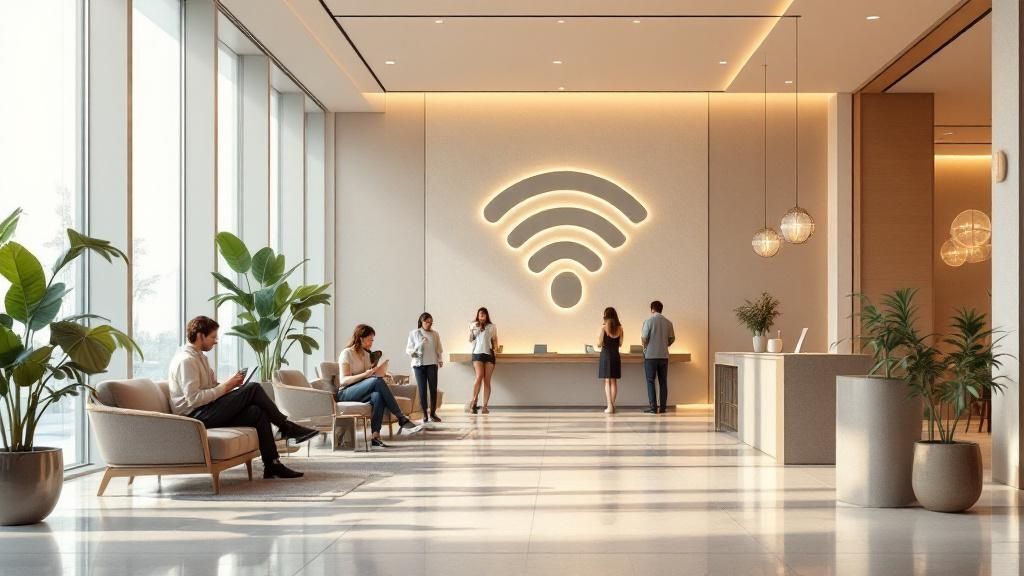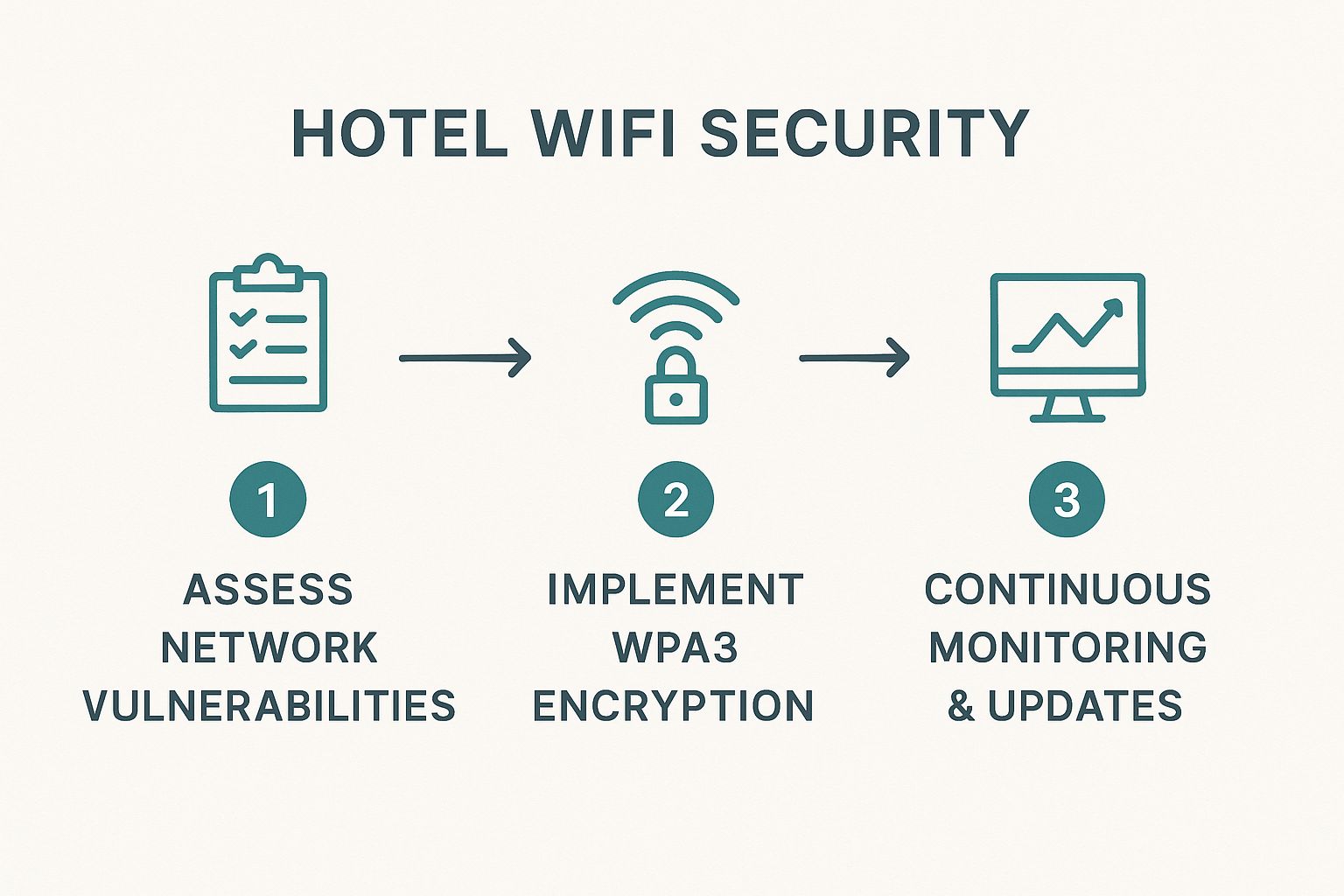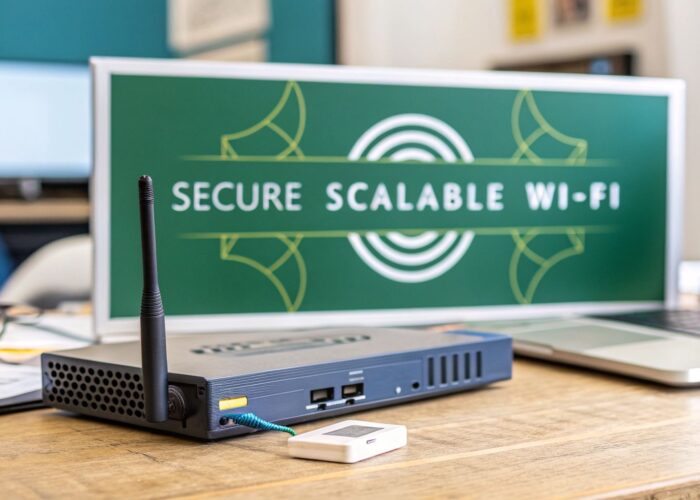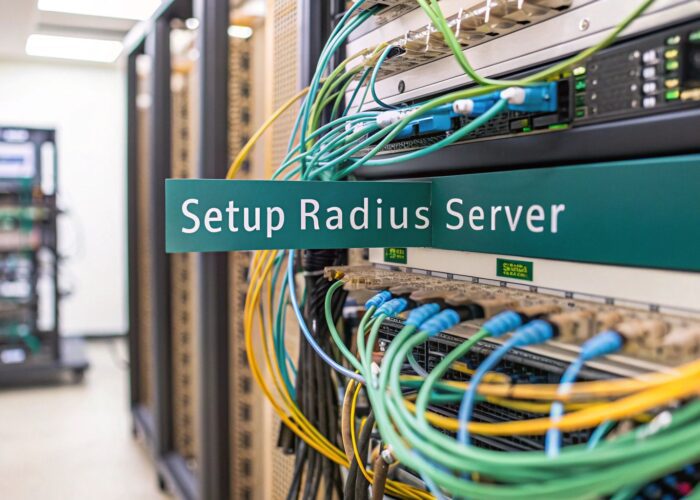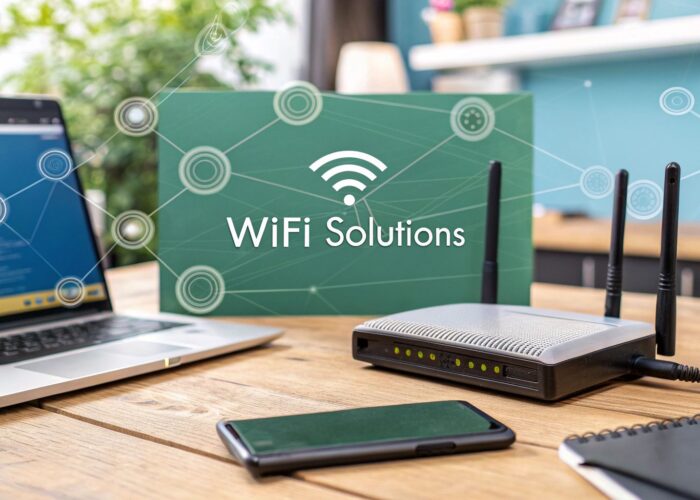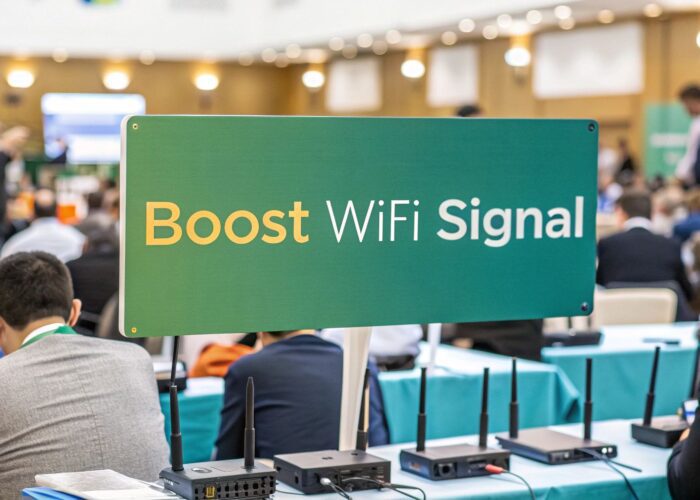Let's be honest, hotel WiFi used to be a simple utility. You'd get a password at check-in, log on, and hope for the best. But those days are long gone. Today's hotel WiFi solutions are sophisticated platforms designed to do much more than just get your guests online. They're a core part of the guest experience, a powerful marketing tool, and a crucial operational asset, all rolled into one.
What Are Modern Hotel WiFi Solutions
Think of it this way: your old WiFi was like a single key that opened one door. A modern solution is more like a digital concierge—a smart, adaptable system that manages the entire property's network, enhances security, and even creates new ways to delight your guests. It’s the invisible backbone that supports everything from streaming movies in the room to contactless check-in.
A reliable connection isn't just a nice-to-have anymore; it's a non-negotiable for most travelers. The data backs this up. A recent report on hospitality trends found that a staggering 71% of hotel guests are more likely to book a property that offers self-service tech. Things like mobile keys and in-app ordering all depend on a rock-solid WiFi network. You can dig deeper into how tech is reshaping guest decisions in the full report from OysterLink.
More Than Just a Password
At the heart of a modern system, like the platforms built on Cisco Meraki hardware, is the power of centralized management. This gives your staff a bird's-eye view of the entire network—from the front desk to the penthouse suite—all from a single, easy-to-use dashboard. It takes a historically complex and frustrating task and makes it simple.
So, what makes these systems different? It comes down to a few key ingredients:
-
Captive Portals: This is the branded login page your guests first interact with. It's your digital front door, a chance to make a great first impression. You can use it to share special offers, display your terms of service, or simply welcome guests with a beautiful, on-brand message.
-
Secure Authentication Solutions: The days of one password for the entire hotel are over. That's a huge security risk. Modern systems use much smarter authentication methods. Technologies like IPSK (Identity Pre-Shared Key) or EasyPSK assign a unique, private password to every single guest or device. It’s the same kind of security you’d find in a corporate office, ensuring each guest's connection is private and shielded from others.
Learning from Other Sectors
The hospitality industry didn't invent these technologies in a vacuum. The best hotel WiFi solutions have actually borrowed and perfected ideas from other fields.
The challenge of securely managing hundreds of personal devices (BYOD or "Bring Your Own Device") in a corporate setting is almost identical to handling the flood of guest smartphones, tablets, and laptops. Likewise, the techniques for managing high-density networks in education settings like universities or in a busy retail mall are perfectly suited for a hotel lobby or conference center.
By pulling these advanced features together, a hotel can provide a WiFi experience that is not only fast and dependable but also incredibly secure and personalized. You're no longer just ticking a box for an amenity; you're creating a memorable touchpoint that drives great reviews and brings guests back.
To put it all together, here’s a quick breakdown of the core components and what they do for you and your guests.
Key Components of a Modern Hotel WiFi Solution
This table gives a quick look at the essential elements that transform basic internet into a full-fledged hotel WiFi solution.
|
Component |
What It Does for the Hotel |
What It Does for the Guest |
|---|---|---|
|
Centralized Dashboard |
Simplifies network management, monitoring, and troubleshooting across the entire property. |
Ensures a more stable and reliable connection with fewer outages or slowdowns. |
|
Captive Portal |
Creates a branded welcome experience, captures marketing data, and communicates promotions. |
Provides a simple, clear, and branded way to log in and get online. |
|
Secure Authentication |
Drastically improves network security by isolating each guest’s connection. |
Gives peace of mind that their personal data is safe and their connection is private. |
|
Analytics & Reporting |
Gathers valuable data on guest behavior, network usage, and foot traffic patterns. |
Helps the hotel optimize the network for a better, faster experience for everyone. |
|
Integrations |
Integrates WiFi data with other hotel systems such as Opera Micros PMS, CRM, or marketing platforms. |
Enables personalized experiences, like a welcome message upon connecting or targeted offers. |
Ultimately, each piece works together to turn a basic utility into a strategic tool that improves operations, boosts marketing, and leaves guests feeling connected and cared for.
Why Your Old WiFi System Is Costing You Guests
Ever wondered why the same router that works perfectly fine in your office just can't keep up in a hotel? It’s like asking a string quartet to headline a rock festival. The scale, the environment, and what the audience expects are worlds apart. Using the wrong tool for the job always ends in a disappointing performance.
In the hotel world, your WiFi network is a headline act. A recent lodging study found that 92% of guests see a strong WiFi connection as a top priority when deciding where to stay. Let that sink in. Your network isn't just a background amenity; it's a huge factor in whether people book with you or your competitor. An old, underpowered system doesn't just mean slow speeds—it actively costs you guests.
The Unique Pressures of Hospitality WiFi
Consumer-grade or even small-office WiFi solutions simply weren't built for the intense demands of a hotel. They buckle under the strain for a few key reasons.
First, you have high device density. Think about it: a single family of four might bring ten connected devices with them—phones, tablets, laptops, and smartwatches. Now, multiply that across a fully booked property, and you're looking at hundreds, if not thousands, of devices all fighting for bandwidth.
Second, there's the constant guest turnover. Unlike an office with a set number of employees, a hotel’s user base changes every single day. This creates a massive headache for management and security. How do you give hundreds of new people easy access while making sure their connection is safe from everyone else's?
Finally, guests demand seamless coverage. They expect a flawless connection everywhere, from their room to the lobby, the gym, the pool, and even the rooftop bar. A few routers sprinkled around the building just won't get the job done.
Where Generic Solutions Fall Short
When you put a generic system under this kind of pressure, the guest experience falls apart fast. The result is a perfect storm of problems that lead directly to bad reviews and lost business.
-
Slow, Lagging Speeds: When too many devices are competing for limited bandwidth, everyone suffers. Video calls drop, movies buffer endlessly, and even simple web browsing becomes a frustrating chore.
-
Dropped Connections: As guests walk around your property, they constantly lose their connection when moving between weak signal areas, forcing them to log in over and over again.
-
Major Security Gaps: Handing out the same password to every guest is a huge security risk. It creates a "flat" network where one person's compromised device could potentially see another guest's online activity—a liability you can't afford.
This is where specialized hotel WiFi solutions, especially those powered by platforms like Cisco Meraki, become so important. They are engineered from the ground up to handle these exact challenges. Meraki's cloud-managed access points are specifically designed for high-density environments, ensuring every single guest gets a strong, stable signal.
Using a system not designed for hospitality is like trying to manage a busy restaurant's reservations on a sticky note. Sooner or later, things will fall apart, customers will get angry, and they won't come back.
The real magic, though, is in the software. From a single, central dashboard, you can manage bandwidth, keep an eye on network health, and set up serious security protocols. Advanced authentication solutions like IPSK (Identity Pre-Shared Key) or EasyPSK can give each guest their own unique network password. This approach, borrowed from high-security BYOD corporate sectors, essentially gives every guest their own private, secure lane on the WiFi highway.
That's a level of security and performance a standard router could never even dream of providing.
The Power of Captive Portals and Smart Authentication
Let's talk about that first digital handshake your hotel has with a guest: the Wi-Fi login screen. It’s so much more than just a place to type a password. It's a powerful tool known as a captive portal.
Think of it as your hotel's digital front door. It’s the very first thing guests interact with online, making it a prime opportunity to set the right tone. A well-designed captive portal can greet guests with your hotel's branding, showcase stunning property photos, and even promote your restaurant, spa, or daily happy hour. It turns a mundane login into an engaging welcome.
Want to get into the nitty-gritty? Our complete manager's guide to what a captive portal is covers all the technical details.
This isn't just a "nice-to-have" feature anymore; it's big business. The market for specialized hotel Wi-Fi management software is booming, with a projected value of around $500 million in 2025. It's expected to grow at about 15% annually through 2033. This growth is fueled by features like captive portals, which have become essential for delivering top-tier service. You can explore more of these trends in this insightful industry analysis.
Beyond the Welcome Screen: Smart Authentication
After that initial welcome, the next step is authentication—confirming your guest is who they say they are. In the old days, this often meant a single password for the entire hotel. That's a huge security headache.
Today’s modern hotel Wi-Fi solutions use much smarter, more secure methods. Many of these were battle-tested in demanding environments like corporate BYOD (Bring Your Own Device) programs and university campuses. Platforms from vendors like Cisco Meraki are particularly good at providing these advanced authentication solutions, letting you move past the one-size-fits-all password and into a more secure, personalized network experience for every guest.
This is where things get really interesting.
Imagine giving every guest a unique, private key that only unlocks their personal lane on the Wi-Fi highway. That's the essence of today's best authentication practices. It ensures one guest's online activity is completely isolated from another's, creating a secure bubble for each user.
Introducing IPSK: The Private Key to Guest Wi-Fi
One of the most effective ways to create this secure bubble is with Identity Pre-Shared Key, or IPSK. It might sound technical, but the concept is beautifully simple. Instead of one password for everyone, IPSK technology generates a unique, private password for each guest or even each of their devices.
This approach delivers some serious benefits:
-
Enhanced Security: With individual keys, you eliminate the risk of guests snooping on each other's traffic. If one device gets compromised, the problem is contained and can't spread to others on the network.
-
Personalization: You can tie the unique key to a guest's room number, last name, or loyalty status, making the login process feel personal and seamless.
-
Simplified Management: Don't worry, your IT staff won't be manually creating thousands of passwords. Solutions like EasyPSK make managing all these unique keys incredibly simple, often by automating the whole process through an integration with your Property Management System (PMS).
This strategy is pulled directly from high-security playbooks. Think of a corporate office managing thousands of employees bringing their own devices (BYOD corporate sectors) or a university campus securing its student network. The same principles that protect sensitive data in retail and education are now easily accessible to protect your guests.
By building on a Cisco Meraki backbone, implementing an IPSK solution creates a robust, secure, and friendly network that builds trust and keeps your guests coming back.
Choosing the Right WiFi Platform for Your Hotel
Picking the right platform for your hotel WiFi solutions is one of the most important technology decisions you'll make. This isn't just about buying hardware. It’s about choosing a long-term partner and an ecosystem that will shape your operations and guest experience for years to come. The market is crowded, but a few key players like Cisco and its cloud-first Meraki line have earned their reputation for a reason.
Think of it this way: you could hire a separate manager for every single task on-site, or you could have one highly skilled executive who oversees everything from a central hub. That’s the real difference between traditional on-premise controllers and modern cloud-managed platforms.
On-Premises vs. Cloud-Managed WiFi
For a long time, managing a serious business network meant having a physical controller—a box humming away in a server closet on your property. This controller was the network's brain. If you managed multiple hotels, you needed multiple brains, which made everything complicated and disconnected.
Today's best solutions have moved that brain into the cloud. Platforms like Cisco Meraki are managed through a simple, web-based dashboard. This means your IT team, or even a less technical manager, can monitor, update, and fix issues across all your properties from a single screen, anywhere with an internet connection.
-
Scalability: Want to add a new access point or bring a new hotel online? Just plug in the device and add it to your dashboard. It's that simple.
-
Ease of Management: Say goodbye to complex command-line interfaces. A cloud dashboard gives you a visual, intuitive way to run your network.
-
Future-Proofing: New features, performance boosts, and critical security patches are pushed out automatically from the cloud. Your system stays up-to-date without you having to lift a finger.
Why Cisco Meraki Excels in Hospitality
Cisco Meraki has become a go-to choice in the hospitality world because it was practically built to solve the industry's biggest headaches. The mix of high-performance hardware and a brilliantly simple dashboard is a huge win for hoteliers. On top of that, its security features are rock-solid, which is non-negotiable when you're responsible for protecting guest data.
A great WiFi platform does more than just provide internet access. It provides peace of mind for you and a secure, frictionless experience for your guests. It’s the foundation upon which great reviews are built.
One of its most impressive capabilities is its support for advanced authentication solutions. We've already talked about Captive Portals, and Meraki handles those beautifully with deep customization. But its true security muscle shows with its support for methods like IPSK (Identity Pre-Shared Key).
This technology was honed in demanding environments like BYOD corporate sectors and sprawling education campuses, and it’s the gold standard for guest network security. With a solution like EasyPSK, you can automatically generate a unique, private password for every single guest, often by integrating it directly with your hotel’s PMS. This creates a secure "bubble" around each guest's connection—a feature that builds immense trust. You’re essentially giving them the same level of security a large corporation uses to protect its own sensitive data.
This ability to borrow battle-tested practices from other industries, like retail and education, and apply them to hospitality is what makes a platform like Meraki so powerful. It’s engineered to handle the high density, high turnover, and high security demands of any modern hotel. Choosing a platform with this kind of flexibility ensures your investment doesn't just meet today’s needs but is ready for whatever comes next.
What Hotels Can Learn from Other Industries
Sometimes, the best ideas are found by looking over the fence. The hospitality industry has its own unique mix of Wi-Fi challenges, but many of them have already been tackled and refined in other fields. By seeing what works in Education, Retail, and corporate BYOD environments, you can adopt proven hotel Wi-Fi solutions that truly impress your guests.
Think about it for a moment. A bustling hotel lobby has a lot in common with a university common area, a mall food court, or a busy corporate office. They're all high-density spots where dozens, or even hundreds, of personal devices are all fighting for bandwidth at the same time. The strategies that keep these places online and running smoothly can be directly applied to the hotel world.
Lessons from Education and High-Density Environments
University campuses are the ultimate testing ground for managing high-density networks. They have to provide rock-solid access for thousands of students, each with multiple devices, all while keeping the network secure from threats. Their secret sauce often involves powerful access points, like those from Cisco Meraki, combined with intelligent network design that anticipates and manages heavy loads.
Hotels can borrow this exact playbook for handling peak times in their own high-traffic areas, like conference centers, lobbies, and restaurants. By strategically placing access points and actively managing bandwidth, you can ensure a big event doesn’t bring the entire guest network to a screeching halt.
The Retail Playbook for Guest Engagement
Retailers have perfected the art of using Wi-Fi for much more than just a free connection. They use Captive Portals not just for logging in, but as a direct marketing channel. When a shopper connects, they're greeted with special offers, loyalty program sign-ups, and engaging ads.
This simple shift turns a basic utility into a direct line of communication with the customer. A hotel's captive portal can do the exact same thing, promoting spa services, dinner reservations, or late check-out packages right when a guest connects.
Retailers also lean heavily on Wi-Fi analytics to map out foot traffic and understand shopper behavior. In the same way, a Cisco Meraki dashboard can reveal which areas of your hotel are the busiest, helping you make smarter decisions about staffing and amenity placement. For hotels ready to take it a step further, a specialized SplashAccess hotel integration can provide even deeper analytics and more powerful tools for guest engagement.
Borrowing Security from the Corporate World
Perhaps the most critical lessons for hotels come from the corporate world, specifically from how they handle BYOD (Bring Your Own Device) policies. Businesses have spent years perfecting secure methods for onboarding employee-owned devices without putting sensitive company data at risk. The gold standard? Giving every single user their own unique credentials.
This is where advanced Authentication Solutions like IPSK (Identity Pre-Shared Key) and EasyPSK enter the picture. Instead of a single, shared password for the entire hotel—a huge security vulnerability—these systems generate a unique, private password for each guest or room. It’s like giving every guest the key to their own personal Wi-Fi network.
This approach effectively isolates each guest's traffic, preventing them from seeing other devices on the network. It delivers the ultimate peace of mind, bringing enterprise-grade security to the hospitality environment. By adopting these security models, you're not just offering Wi-Fi; you're offering a secure, trustworthy connection that protects your guests and your reputation.
WiFi Lessons from Other Industries for Hotels
Hospitality isn't alone in its quest for better WiFi. Looking at how other sectors solve similar problems provides a clear roadmap for innovation.
|
Sector |
Key WiFi Challenge |
Innovative Solution |
Hotel Application |
|---|---|---|---|
|
Education |
Extreme high-density usage in lecture halls and common areas. |
Advanced network planning and robust access points to handle thousands of simultaneous connections. |
Apply the same principles to manage WiFi in busy conference centers, lobbies, and restaurants during peak hours. |
|
Retail |
Turning a free utility into a revenue and data generator. |
Using captive portals for marketing, promotions, and loyalty sign-ups. Collecting foot traffic analytics. |
Transform the login page into a marketing tool for hotel amenities (spa, dining) and gather data on guest movement. |
|
Corporate BYOD |
Securing the network when employees connect personal devices. |
Implementing identity-based access with unique credentials for each user (e.g., IPSK) to isolate traffic. |
Provide each guest or room with a unique WiFi password, creating a secure, private connection that builds trust. |
By learning from these industries, hotels can move beyond simply providing a connection and start creating a WiFi experience that is secure, engaging, and exceptionally reliable.
Your Step-by-Step WiFi Implementation Plan
So, you’ve picked your platform and are ready to make the switch. Now for the fun part—the actual rollout. Don't sweat it, though. A solid implementation plan is the difference between a smooth, successful launch and a chaotic mess. It's like building a house; you wouldn't just start throwing up walls without a blueprint. The same goes for your hotel WiFi solutions.
First things first: the site survey. This is more than just a casual walkthrough to guess where the access points should go. A professional survey is a technical deep dive that maps your entire property. It pinpoints potential dead zones, identifies sources of signal interference (like concrete walls or elevator shafts), and flags high-traffic areas. This survey is the bedrock for strategically placing hardware, like Cisco Meraki access points, to ensure flawless coverage from the basement gym to the penthouse suite.
Planning for Secure Segmentation
Next up is network segmentation. In today's world, a single, wide-open hotel network is a massive security risk. You need to create separate, secure "lanes" for different types of traffic. Think of it like a highway system—one lane for guest traffic, another for staff, and a third for all your smart devices. This is a non-negotiable security measure that protects both your operations and your guests.
Your segmentation plan should break down into a few key networks:
-
Guest Network: This is the public-facing network your guests will connect to, typically managed through a Captive Portal.
-
Operational Network: A locked-down, private network for your internal team and critical hotel systems, including your PMS, point-of-sale terminals, and security cameras.
-
IoT Network: A dedicated network for all your "smart" devices—think thermostats, keyless door locks, and voice assistants. This keeps them isolated from more sensitive data.
This strategy, which is standard practice in BYOD corporate sectors, ensures that a security breach on one network can't bleed over and compromise another. Platforms like Cisco Meraki make it surprisingly simple to manage these separate virtual networks from one central dashboard.
This security workflow provides a clear visual path for keeping your network secure.
The graphic really drives home the idea of a continuous cycle: assess, implement, and monitor. It’s the only way to maintain a strong security posture over the long term.
The Power of a Smart Authentication Rollout
This is also the phase where you map out your Authentication Solutions. Are you going with a simple shared password? Or will you offer social media logins through your captive portal? For the best security and a truly premium guest experience, implementing an IPSK or EasyPSK system is the gold standard. These systems generate a unique key for each guest, essentially giving them their own personal, private network during their stay.
A new system rollout doesn't have to disrupt your entire hotel. A phased approach is often best. Start with a single floor or a specific wing to test everything out and iron out any kinks before going live everywhere. A smooth transition is crucial for keeping guest satisfaction high.
The demand for great Wi-Fi isn't just a trend; it's an expectation. The global market for guest Wi-Fi providers is projected to hit $2.88 billion in 2025 and is forecasted to rocket past $7.25 billion by 2033. Those numbers tell a clear story about what guests demand.
For a more granular look at deploying these systems, our guide on creating a hotel integration plan is an invaluable resource.
Once your new system is up and running, your work isn't over. The final piece of the puzzle is ongoing monitoring and optimization. The Cisco Meraki dashboard offers incredible visibility into your network's health, allowing you to spot bottlenecks, analyze how guests are using the Wi-Fi, and make smart, data-driven tweaks to keep everything running perfectly. This proactive management ensures your investment continues to pay off in happy guests long after the installation crew has gone home.
Still curious about what it takes to get your property’s network up to speed? You're in good company. Here are some of the most common questions we hear from hoteliers, with straightforward answers to help you figure out your next steps.
How Is Hotel WiFi Different from Home WiFi?
The easiest way to think about it is to compare roads. Your home WiFi is like a quiet residential street, built for just a few cars. A hotel’s network, however, is a massive, multi-lane highway built to handle constant, peak-hour traffic from hundreds of different vehicles. It needs completely different infrastructure.
This means using specialized hardware, like access points from Cisco Meraki, that won't buckle under the pressure of hundreds of phones, laptops, and tablets all trying to connect at once. It also requires sophisticated software for security and management. We're talking about serious Authentication Solutions like IPSK (Identity Pre-Shared Key), which gives every single guest their own private, secure "lane" on your network—something your router at home just isn't designed for. This kind of tech is borrowed from high-security environments like education campuses and corporate BYOD settings for a reason.
What Is a Captive Portal Used For?
That branded login page you see right after connecting to a hotel's network? That's the Captive Portal. Think of it as your property's digital front door. At its core, its job is to authenticate users and make sure only authorized guests get on the network. But it's become so much more than that.
Smart hoteliers now use their captive portals as a prime piece of marketing real estate. It's the perfect spot to advertise a spa discount, show off the dinner menu, or offer a deal on late check-out. It’s your very first opportunity to connect with a guest digitally and shape their experience, a strategy that the retail world mastered years ago.
A captive portal turns a simple login process into a strategic touchpoint. It’s where you transform a basic utility into a branded guest experience, driving engagement and creating new revenue opportunities from the moment a guest connects.
Can I Offer Different WiFi Speeds to Different Guests?
Yes, absolutely. In fact, this is one of the most valuable features of a modern hotel WiFi solution. With a good management dashboard, like the kind Cisco Meraki provides, setting up different access tiers is surprisingly simple.
Here’s a common setup:
-
Complimentary Basic WiFi: Offer a standard-speed connection to every guest, perfect for checking emails and light browsing.
-
Premium High-Speed WiFi: Provide a much faster connection for a small fee, or include it as a complimentary perk for your loyalty members or guests staying in premium suites. This is ideal for streaming movies or handling video calls.
This kind of flexibility lets you manage guest expectations effectively while opening up a new revenue stream. And it's all controlled from one single, central dashboard. With advanced tools like EasyPSK, you can even tie these different speed tiers to each guest's unique password, making the upgrade process completely seamless.
Ready to give your guests the secure, fast, and engaging connection they expect? Splash Access offers an instantly deployable platform built on Cisco Meraki that makes sophisticated features like IPSK and custom captive portals incredibly easy to manage. Learn more at Splash Access and see how you can transform your guest WiFi experience.
Article created using Outrank
